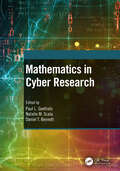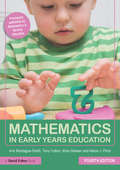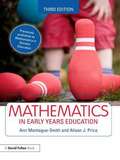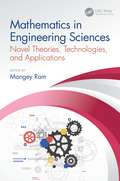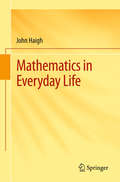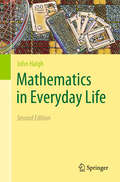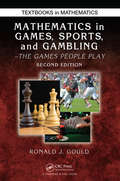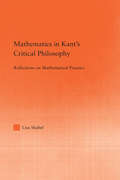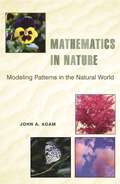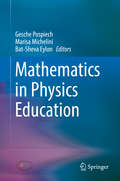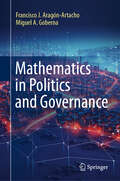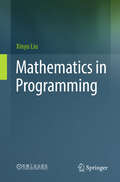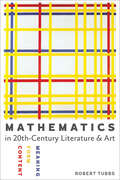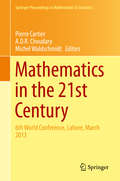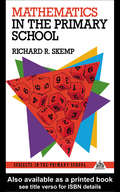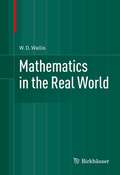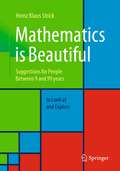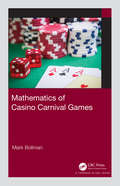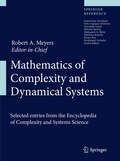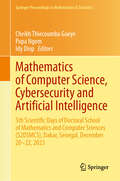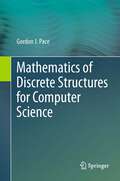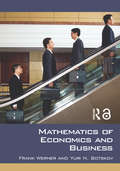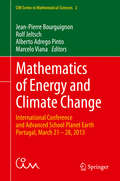- Table View
- List View
Mathematics in Cyber Research
by Paul L. GoethalsIn the last decade, both scholars and practitioners have sought novel ways to address the problem of cybersecurity. Innovative outcomes have included applications such as blockchain as well as creative methods for cyber forensics, software development, and intrusion prevention. Accompanying these technological advancements, discussion on cyber matters at national and international levels has focused primarily on the topics of law, policy, and strategy. The objective of these efforts is typically to promote security by establishing agreements among stakeholders on regulatory activities. Varying levels of investment in cyberspace, however, comes with varying levels of risk; in some ways, this can translate directly to the degree of emphasis for pushing substantial change. At the very foundation or root of cyberspace systems and processes are tenets and rules governed by principles in mathematics. Topics such as encrypting or decrypting file transmissions, modeling networks, performing data analysis, quantifying uncertainty, measuring risk, and weighing decisions or adversarial courses of action represent a very small subset of activities highlighted by mathematics. To facilitate education and a greater awareness of the role of mathematics in cyber systems and processes, a description of research in this area is needed. Mathematics in Cyber Research aims to familiarize educators and young researchers with the breadth of mathematics in cyber-related research. Each chapter introduces a mathematical sub-field, describes relevant work in this field associated with the cyber domain, provides methods and tools, as well as details cyber research examples or case studies. Features One of the only books to bring together such a diverse and comprehensive range of topics within mathematics and apply them to cyber research. Suitable for college undergraduate students or educators that are either interested in learning about cyber-related mathematics or intend to perform research within the cyber domain. The book may also appeal to practitioners within the commercial or government industry sectors. Most national and international venues for collaboration and discussion on cyber matters have focused primarily on the topics of law, policy, strategy, and technology. This book is among the first to address the underpinning mathematics.
Mathematics in Early Years Education
by Alice Hansen Ann Montague-Smith Alison J. Price Tony CottonThis fourth edition of the bestselling Mathematics in Early Years Education provides an accessible introduction to the teaching of mathematics in the early years. Covering all areas of mathematics – number and counting, calculation, pattern, shape, measures and data handling – it provides a wide range of practical activities and guidance on how to support young children’s mathematical development. There is also guidance on managing the transition to KS1 and a strong emphasis throughout on creating home links and working in partnership with parents. This new edition has been fully updated to incorporate the latest research and thinking in this area and includes: why mathematics is important as a way of making sense of the world how attitudes to mathematics can influence teaching and learning how children learn mathematics and what they are capable of learning how technology can support maths teaching maths phobia and the impact society has on maths teaching material on sorting, matching and handling data the importance of educating about finance in today’s world ideas for observation and questioning to assess children’s understanding examples of planned activities suggestions for language development assessment criteria. This textbook is ideal for those training to be teachers through an undergraduate or PGCE route, those training for Early Years Professional Status and those studying early childhood on foundation or honours degrees, as well as parents looking to explore how their young children learn mathematics. This will be an essential text for any early years practitioner looking to make mathematics interesting, exciting and engaging in their classroom.
Mathematics in Early Years Education
by Ann Montague-Smith Alison J. PriceThis third edition of the best-selling Mathematics in Nursery Education provides an accessible introduction to the teaching of mathematics in the early years. Covering all areas of mathematics learning - number and counting, calculation, pattern, shape, measures and data handling - it summarises the research findings and underlying key concepts and explains how adults can help children to learn through practical experiences, discussion and more direct intervention. This new edition has been fully updated to incorporate the latest research and thinking in this area and includes: why mathematics is important as a way of making sense of the world how attitudes to mathematics can influence teaching and learning how children learn mathematics new material on sorting, matching and handling data ideas for observation and questioning to assess children's understanding examples of planned activities suggestions for language development assessment criteria. This textbook is ideal for those training to be teachers through an undergraduate or PGCE route, those training for Early Years Professional Status and those studying early childhood on foundation or honours degrees as well as parents looking to explore how their young children learn mathematics. This will be an essential text for any Early Years practitioner looking to make mathematics interesting, exciting and engaging in their classroom.
Mathematics in Engineering Sciences: Novel Theories, Technologies, and Applications (Mathematical Engineering, Manufacturing, and Management Sciences)
by Mangey RamThis book includes research studies, novel theory, as well as new methodology and applications in mathematics and management sciences. The book will provide a comprehensive range of mathematics applied to engineering areas for different tasks. It will offer an international perspective and a bridge between classical theory and new methodology in many areas, along with real-life applications. Features Offers solutions to multi-objective transportation problem under cost reliability using utility function Presents optimization techniques to support eco-efficiency assessment in manufacturing processes Covers distance-based function approach for optimal design of engineering processes with multiple quality characteristics Provides discrete time sliding mode control for non-linear networked control systems Discusses Bejan number and second law of thermodynamics as instruments for optimizing fluid dynamic systems and aerodynamic systems
Mathematics in Everyday Life
by John HaighHow does mathematics impact everyday events? The purpose of this book is to show a range of examples where mathematics can be seen at work in everyday life. From money (APR, mortgage repayments,personal finance), simple first and second order ODEs, sport and games (tennis,rugby, athletics, darts, tournament design, soccer, snooker), business (stockcontrol, linear programming, check digits, promotion policies, investment), thesocial sciences (voting methods, Simpson's Paradox, drug testing, measurementsof inequality) to TV game shows and even gambling (lotteries, roulette, poker, horseracing), the mathematics behind commonplace events is explored. Fully worked examples illustrate the ideas discussed and each chapterends with a collection of exercises. Everyday Mathematics supports other first year modules by giving students extra practice in working with calculus, linear algebra, geometry, trigonometry and probability. Secondary/high school level mathematics is all that is required for students to understand the material. Those students whose degree course includes writing an extendedmathematical essay will find many suitable topics here, with pointers to extendand develop the material.
Mathematics in Everyday Life
by John HaighHow does mathematics impact everyday events? Through concrete examples from business, sport, games, computing, and society, this book explores the mathematics underpinning our everyday lives.The examples covered in the book include game shows, internet search engines, mortgage payments, drug testing, soccer tournaments, social inequality, voting, and much more. Throughout, the reader's mathematical knowledge is broadened with new topics such as differential equations, eigenvalues of matrices, linear programming, and modular arithmetic. Fully worked examples illustrate the ideas discussed and each chapter includes exercises to develop the reader's understanding. This new edition has been thoroughly updated, and includes a completely new chapter on applications of mathematics to computing.Mathematics in Everyday Life supports beginning university students in science and engineering by offering extra practice in calculus, linear algebra, geometry, trigonometry, elementary number theory, and probability. Students whose degree course includes writing an extended mathematical essay will find many suitable topics here, with pointers to extend and develop the material.
Mathematics in Games, Sports, and Gambling: The Games People Play, Second Edition (Textbooks in Mathematics)
by Ronald J. GouldMathematics in Games, Sports, and Gambling: The Games People Play, Second Edition demonstrates how discrete probability, statistics, and elementary discrete mathematics are used in games, sports, and gambling situations. With emphasis on mathematical thinking and problem solving, the text draws on numerous examples, questions, and problems to expla
Mathematics in India
by Kim PlofkerBased on extensive research in Sanskrit sources, Mathematics in India chronicles the development of mathematical techniques and texts in South Asia from antiquity to the early modern period. Kim Plofker reexamines the few facts about Indian mathematics that have become common knowledge--such as the Indian origin of Arabic numerals--and she sets them in a larger textual and cultural framework. The book details aspects of the subject that have been largely passed over in the past, including the relationships between Indian mathematics and astronomy, and their cross-fertilizations with Islamic scientific traditions. Plofker shows that Indian mathematics appears not as a disconnected set of discoveries, but as a lively, diverse, yet strongly unified discipline, intimately linked to other Indian forms of learning. Far more than in other areas of the history of mathematics, the literature on Indian mathematics reveals huge discrepancies between what researchers generally agree on and what general readers pick up from popular ideas. This book explains with candor the chief controversies causing these discrepancies--both the flaws in many popular claims, and the uncertainties underlying many scholarly conclusions. Supplementing the main narrative are biographical resources for dozens of Indian mathematicians; a guide to key features of Sanskrit for the non-Indologist; and illustrations of manuscripts, inscriptions, and artifacts. Mathematics in India provides a rich and complex understanding of the Indian mathematical tradition. **Author's note: The concept of "computational positivism" in Indian mathematical science, mentioned on p. 120, is due to Prof. Roddam Narasimha and is explored in more detail in some of his works, including "The Indian half of Needham's question: some thoughts on axioms, models, algorithms, and computational positivism" (Interdisciplinary Science Reviews 28, 2003, 1-13).
Mathematics in Kant's Critical Philosophy: Reflections on Mathematical Practice
by Lisa ShabelFirst published in 2003. Routledge is an imprint of Taylor & Francis, an informa company.
Mathematics in Nature: Modeling Patterns in the Natural World
by John AdamFrom rainbows, river meanders, and shadows to spider webs, honeycombs, and the markings on animal coats, the visible world is full of patterns that can be described mathematically. Examining such readily observable phenomena, this book introduces readers to the beauty of nature as revealed by mathematics and the beauty of mathematics as revealed in nature. Generously illustrated, written in an informal style, and replete with examples from everyday life, Mathematics in Nature is an excellent and undaunting introduction to the ideas and methods of mathematical modeling. It illustrates how mathematics can be used to formulate and solve puzzles observed in nature and to interpret the solutions. In the process, it teaches such topics as the art of estimation and the effects of scale, particularly what happens as things get bigger. Readers will develop an understanding of the symbiosis that exists between basic scientific principles and their mathematical expressions as well as a deeper appreciation for such natural phenomena as cloud formations, halos and glories, tree heights and leaf patterns, butterfly and moth wings, and even puddles and mud cracks. Developed out of a university course, this book makes an ideal supplemental text for courses in applied mathematics and mathematical modeling. It will also appeal to mathematics educators and enthusiasts at all levels, and is designed so that it can be dipped into at leisure.
Mathematics in Physics Education
by Marisa Michelini Gesche Pospiech Bat-Sheva EylonThis book is about mathematics in physics education, the difficulties students have in learning physics, and the way in which mathematization can help to improve physics teaching and learning. The book brings together different teaching and learning perspectives, and addresses both fundamental considerations and practical aspects. Divided into four parts, the book starts out with theoretical viewpoints that enlighten the interplay of physics and mathematics also including historical developments. The second part delves into the learners’ perspective. It addresses aspects of the learning by secondary school students as well as by students just entering university, or teacher students. Topics discussed range from problem solving over the role of graphs to integrated mathematics and physics learning. The third part includes a broad range of subjects from teachers’ views and knowledge, the analysis of classroom discourse and an evaluated teaching proposal. The last part describes approaches that take up mathematization in a broader interpretation, and includes the presentation of a model for physics teachers’ pedagogical content knowledge (PCK) specific to the role of mathematics in physics.
Mathematics in Politics and Governance
by Miguel A. Goberna Francisco J. Aragón-ArtachoThis book presents the mathematical tools that politicians use to make rational decisions about health, education, culture, economy, finance, transportation, and national defense for their citizens. The selection of topics addressed is based on the experiences of four veteran politicians who have doctorates or master’s degrees in mathematics. The exposition also considers the mathematical tools used by politicians to capture votes or optimize their impact on the design of electoral districts, i.e., gerrymandering, without forgetting the mathematics applied to parliamentary activity and political science.Aimed at a general educated readership, a basic knowledge of mathematics is the only requisite to understanding most of the book. Certain sections, denoted in the book with a star, contain more advanced material and require some knowledge of undergraduate math. A later chapter is dedicated to applications and techniques of machine learning and the final chapter discusses a variety of cases where political decisions have affected mathematical development. Readers gravitating towards this book are those who are curious about the history of mathematics, including optimizers and mathematicians who would like to learn more about the historical roots of their discipline. There will also be strong appeal to mathematically-oriented economists, political scientists, and people generally interested in mathematics.Mathematics is – or it should be! – an important part of our culture. The impact of mathematics is sometimes silent, but a powerful one. The authors of this book did an incredible work in digging out areas of mathematical reasoning that pervades social and political life. Reading this book, we will all enrich our vision of mathematics’ value for society.(Nuno Crato, Professor of Applied Mathematics, University of Lisbon, former minister of Education and Science of Portugal 2011–2015)This monograph shows in an impressive way that mathematics can be very helpful in making and evaluating political decisions and that it is indispensable in the progressive penetration of all areas of society with scientific methods. This also includes politics. Not everything in politics can be justified or related to mathematics, but politics should not be made in contradiction to mathematical truths. For me, this is a central message of this publication.(Johanna Wanka, Professor of Applied Mathematics, Merseburg University of Applied Sciences, former Minister of Education and Research, Germany 2013–2018)
Mathematics in Programming
by Xinyu LiuThe book presents the mathematical view and tools of computer programming with broad and friendly context. It explains the basic concepts such as recursion, computation model, types, data, and etc. The book serves as an introductory and reference guide to the engineers, students, researchers, and professionals who are interested in functional programming, type system, and computer programming languages. The book covers seven topics. Firstly, it lays out the number system based on Peano Axioms and demonstrates the isomorphic computer data structures. Then, it introduces Lambda calculus as a computing model and recursion, an important programming structure, with the Y-combinator. It next presents the basic abstract algebra, including group and fields, and provides a friendly introduction to Galois theory. After that, it uses category theory as a tool to explain several concepts in computer programming, including the type system, polymorphism, null handler, and recursive data types, then followed by an application of program optimization. In the last two chapters, the author shows how to program with the concept of infinity through stream and lazy evaluation, and then explains the naïve set theory and transfinite numbers, from which the logic paradox arises. Finally, it introduces four historical views of mathematical foundation, as well as Gödel’s incompleteness theorems developed in 1930s, and how they define the boundaries of computer programming. Additionally, the book provides biographies, stories, and anecdotes of 25 mathematicians, along with over 130 exercises and their corresponding answers.
Mathematics in Twentieth-Century Literature & Art: Content, Form, Meaning
by Robert TubbsThe author of What Is a Number? examines the relationship between mathematics and art and literature of the 20th century.During the twentieth century, many artists and writers turned to abstract mathematical ideas to help them realize their aesthetic ambitions. Man Ray, Marcel Duchamp, and, perhaps most famously, Piet Mondrian used principles of mathematics in their work. Was it coincidence, or were these artists following their instincts, which were ruled by mathematical underpinnings, such as optimal solutions for filling a space? If math exists within visual art, can it be found within literary pursuits? In short, just what is the relationship between mathematics and the creative arts?In this exploration of mathematical ideas in art and literature, Robert Tubbs argues that the links are much stronger than previously imagined and exceed both coincidence and commonality of purpose. Not only does he argue that mathematical ideas guided the aesthetic visions of many twentieth-century artists and writers, Tubbs further asserts that artists and writers used math in their creative processes even though they seemed to have no affinity for mathematical thinking.In the end, Tubbs makes the case that art can be better appreciated when the math that inspired it is better understood. An insightful tour of the great masters of the last century and an argument that challenges long-held paradigms, this book will appeal to mathematicians, humanists, and artists, as well as instructors teaching the connections among math, literature, and art.“Though the content of Tubbs’s book is challenging, it is also accessible and should interest many on both sides of the perceived divide between mathematics and the arts.” —Choice
Mathematics in Twentieth-Century Literature and Art: Content, Form, Meaning
by Robert TubbsChips away at the notion of an accidental relationship between math and art and literature.During the twentieth century, many artists and writers turned to abstract mathematical ideas to help them realize their aesthetic ambitions. Man Ray, Marcel Duchamp, and, perhaps most famously, Piet Mondrian used principles of mathematics in their work. Was it mere coincidence, or were these artists simply following their instincts, which in turn were ruled by mathematical underpinnings, such as optimal solutions for filling a space? If math exists within visual art, can it be found within literary pursuits? In short, just what is the relationship between mathematics and the creative arts?In this provocative, original exploration of mathematical ideas in art and literature, Robert Tubbs argues that the links are much stronger than previously imagined and exceed both coincidence and commonality of purpose. Not only does he argue that mathematical ideas guided the aesthetic visions of many twentieth-century artists and writers, Tubbs further asserts that artists and writers used math in their creative processes even though they seemed to have no affinity for mathematical thinking. In the end, Tubbs makes the case that art can be better appreciated when the math that inspired it is better understood. An insightful tour of the great masters of the last century and an argument that challenges long-held paradigms, Mathematics in Twentieth-Century Literature and Art will appeal to mathematicians, humanists, and artists, as well as instructors teaching the connections among math, literature, and art.
Mathematics in the 21st Century
by Pierre Cartier A.D.R. Choudary Michel WaldschmidtNumerous well-presented and important papers from the conference are gathered in the proceedings for the purpose of pointing directions for useful future research in diverse areas of mathematics including algebraic geometry, analysis, commutative algebra, complex analysis, discrete mathematics, dynamical systems, number theory and topology. Several papers on computational and applied mathematics such as wavelet analysis, quantum mechanics, piecewise linear modeling, cosmological models of super symmetry, fluid dynamics, interpolation theory, optimization, ergodic theory and games theory are also presented.
Mathematics in the Primary School (Subjects in the Primary School)
by Richard R. SkempNational Curriculum guidelines emphasise knowledge, understanding and skills. The author, an internationally recognised authority, provides teachers with a clear explanation of these principles, and explains the relation between understanding and skills, and describes their application to the teaching of mathematics. The book contains numerous activities to show how mathematics can be learnt in the primary classroom with understanding and enjoyment, including: * formation of mathematical concepts * construction of knowledge * contents and structure of primary mathematics
Mathematics in the Real World
by W. D. WallisMathematics in the Real World is a self-contained, accessible introduction to the world of mathematics for non-technical majors. With a focus on everyday applications and context, the topics in this textbook build in difficulty and are presented sequentially, starting with a brief review of sets and numbers followed by an introduction to elementary statistics, models, and graph theory. Data and identification numbers are then covered, providing the pathway to voting and finance. Each subject is covered in a concise and clear fashion through the use of real-world applications and the introduction of relevant terminology. Many sample problems - both writing exercises and multiple-choice questions - are included to help develop students' level of understanding and to offer a variety of options to instructors. Covering six major units and outlining a one-semester course, Mathematics in the Real World is aimed at undergraduate liberal art students fulfilling the mathematics requirement in their degree program. This introductory text will be an excellent resource for such courses, and will show students where mathematics arises in their everyday lives.
Mathematics is Beautiful: Suggestions for people between 9 and 99 years to look at and explore
by Heinz Klaus StrickIn 17 chapters, this book attempts to deal with well-known and less well-known topics in mathematics. This is done in a vivid way and therefore the book contains a wealth of colour illustrations. It deals with stars and polygons, rectangles and circles, straight and curved lines, natural numbers, square numbers and much more. If you look at the illustrations, you will discover plenty of exciting and beautiful things in mathematics.The book offers a variety of suggestions to think about what is depicted and to experiment in order to make and check your own assumptions. For many topics, no (or only few) prerequisites from school lessons are needed. It is an important concern of the book that young people find their way to mathematics and that readers whose school days are some time ago discover new things. The numerous references to internet sites and further literature help in this respect. "Solutions" to the suggestions interspersed in the individual sections can be downloaded from the Springer website. The book was thus written for everyone who enjoys mathematics or who would like to understand why the book bears this title. It is also aimed at teachers who want to give their students additional or new motivation to learn.This book is a translation of the original German 2nd edition Mathematik ist schön by Heinz Klaus Strick, published by Springer-Verlag GmbH, DE, part of Springer Nature in 2019. The translation was done with the help of artificial intelligence (machine translation by the service DeepL.com). In the subsequent editing, the author, with the friendly support of John O'Connor, St Andrews University, Scotland, tried to make it closer to a conventional translation. Still, the book may read stylistically differently from a conventional translation. Springer Nature works continuously to further the development of tools for the production of books and on the related technologies to support the authors.
Mathematics of Casino Carnival Games (AK Peters/CRC Recreational Mathematics Series)
by Mark BollmanThere are thousands of books relating to poker, blackjack, roulette and baccarat, including strategy guides, statistical analysis, psychological studies, and much more. However, there are no books on Pell, Rouleno, Street Dice, and many other games that have had a short life in casinos! While this is understandable — most casino gamblers have not heard of these games, and no one is currently playing them — their absence from published works means that some interesting mathematics and gaming history are at risk of being lost forever. Table games other than baccarat, blackjack, craps, and roulette are called carnival games, as a nod to their origin in actual traveling or seasonal carnivals. Mathematics of Casino Carnival Games is a focused look at these games and the mathematics at their foundation. Features • Exercises, with solutions, are included for readers who wish to practice the ideas presented • Suitable for a general audience with an interest in the mathematics of gambling and games • Goes beyond providing practical ‘tips’ for gamblers, and explores the mathematical principles that underpin gambling games
Mathematics of Complexity and Dynamical Systems
by Robert A. MeyersMathematics of Complexity and Dynamical Systems is an authoritative reference to the basic tools and concepts of complexity, systems theory, and dynamical systems from the perspective of pure and applied mathematics. Complex systems are systems that comprise many interacting parts with the ability to generate a new quality of collective behavior through self-organization, e.g. the spontaneous formation of temporal, spatial or functional structures. These systems are often characterized by extreme sensitivity to initial conditions as well as emergent behavior that are not readily predictable or even completely deterministic. The more than 100 entries in this wide-ranging, single source work provide a comprehensive explication of the theory and applications of mathematical complexity, covering ergodic theory, fractals and multifractals, dynamical systems, perturbation theory, solitons, systems and control theory, and related topics. Mathematics of Complexity and Dynamical Systems is an essential reference for all those interested in mathematical complexity, from undergraduate and graduate students up through professional researchers.
Mathematics of Computer Science, Cybersecurity and Artificial Intelligence: 5th Scientific Days of Doctoral School of Mathematics and Computer Sciences (S2DSMCS), Dakar, Senegal, December 20–22, 2023 (Springer Proceedings in Mathematics & Statistics #468)
by Cheikh Thiecoumba Gueye Papa Ngom Idy DiopThis proceedings book gathers selected, peer-reviewed papers presented at the Fifth Scientific Days of the Doctoral School of Mathematics and Computer Sciences - S2DSMCS, held from December 20–22, 2023, at Cheikh Anta Diop University in Dakar, Senegal. The cutting-edge works cover timely topics in cryptography, cybersecurity, and artificial intelligence, with applications extending to fields such as telecommunications and smart networks. This collection showcases research activities developed by a new generation of mathematicians and computer scientists from Africa, Europe, Asia, and America. By fostering cooperation among both young and experienced researchers, the S2DSMSC conference aligns with other conferences in the region, such as Africacrypt - the International Conference on Cryptology in Africa, the Non-commutative Algebra and Operator Theory (NANCAOT) international workshops, and the International Conference in Algebra, Codes, and Cryptology (A2C), all with proceedings published by Springer.
Mathematics of Discrete Structures for Computer Science
by Gordon J. PaceMathematics plays a key role in computer science, some researchers would consider computers as nothing but the physical embodiment of mathematical systems. And whether you are designing a digital circuit, a computer program or a new programming language, you need mathematics to be able to reason about the design -- its correctness, robustness and dependability. This book covers the foundational mathematics necessary for courses in computer science. The common approach to presenting mathematical concepts and operators is to define them in terms of properties they satisfy, and then based on these definitions develop ways of computing the result of applying the operators and prove them correct. This book is mainly written for computer science students, so here the author takes a different approach: he starts by defining ways of calculating the results of applying the operators and then proves that they satisfy various properties. After justifying his underlying approach the author offers detailed chapters covering propositional logic, predicate calculus, sets, relations, discrete structures, structured types, numbers, and reasoning about programs. The book contains chapter and section summaries, detailed proofs and many end-of-section exercises -- key to the learning process. The book is suitable for undergraduate and graduate students, and although the treatment focuses on areas with frequent applications in computer science, the book is also suitable for students of mathematics and engineering.
Mathematics of Economics and Business
by Frank Werner Yuri N. SotskovFor all students who wish to understand current economic and business literature, knowledge of mathematical methods has become a prerequisite. Clear and concise, with precise definitions and theorems, Werner and Sotskov cover all the major topics required to gain a firm grounding in this subject including sequences, series, applications in finance, functions, differentiations, differentials and difference equations, optimizations with and without constraints, integrations and much more. Containing exercises and worked examples, precise definitions and theorems as well as economic applications, this book provides the reader with a comprehensive understanding of the mathematical models and tools used in both economics and business.
Mathematics of Energy and Climate Change
by Marcelo Viana Jean-Pierre Bourguignon Alberto Adrego Pinto Rolf JeltschThe focus of this volume is research carried out as part of the program Mathematics of Planet Earth, which provides a platform to showcase the essential role of mathematics in addressing planetary problems and creating a context for mathematicians and applied scientists to foster mathematical and interdisciplinary developments that will be necessary to tackle a myriad of issues and meet future global challenges. Earth is a planet with dynamic processes in its mantle, oceans and atmosphere creating climate, causing natural disasters and influencing fundamental aspects of life and life-supporting systems. In addition to these natural processes, human activity has increased to the point where it influences the global climate, impacts the ability of the planet to feed itself and threatens the stability of these systems. Issues such as climate change, sustainability, man-made disasters, control of diseases and epidemics, management of resources, risk analysis and global integration have come to the fore. Written by specialists in several fields of mathematics and applied sciences, this book presents the proceedings of the International Conference and Advanced School Planet Earth, Mathematics of Energy and Climate Change held in Lisbon, Portugal, in March 2013, which was organized by the International Center of Mathematics (CIM) as a partner institution of the international program Mathematics of Planet Earth 2013. The book presents the state of the art in advanced research and ultimate techniques in modeling natural, economical and social phenomena. It constitutes a tool and a framework for researchers and graduate students, both in mathematics and applied sciences.
